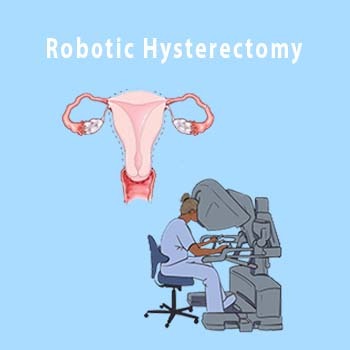ROBOTIC HYSTERECTOMY
-
A hysterectomy is surgery to remove your uterus (partial hysterectomy) or your uterus plus your cervix (total hysterectomy).
If you need a hysterectomy, your doctor might recommend robot-assisted (robotic) surgery. During robotic surgery, your doctor performs the hysterectomy with instruments that are passed through small abdominal cuts (incisions). The magnified, 3D view makes possible great precision, flexibility and control.
When you have a minimally invasive hysterectomy, you're likely to have less pain and lose less blood than is typical with open abdominal surgery. You'll probably be able to resume normal daily activities more quickly than you could after open surgery.
-
Why it's done
Doctors perform hysterectomies to treat conditions such as:
Uterine fibroids
Endometriosis
Cancer or precancer of the uterus, cervix or ovaries
Uterine prolapse
Abnormal vaginal bleeding
Pelvic pain
Your doctor might recommend robotic hysterectomy if he or she believes that you're not a candidate for a vaginal hysterectomy based on your medical history. This might be true if you have surgical scars or some irregularity in your pelvic organs that limits your options.
-
How you prepare
Follow your doctor's instructions about medication. Find out whether you should take your usual medications in the days before your hysterectomy. Be sure to tell your doctor about over-the-counter medications, dietary supplements or herbal preparations that you take.
Arrange for help. Although you're likely to recover sooner after a robotic hysterectomy than after an abdominal one, it still takes time. Ask someone to help you out at home for the first week or so.
-
During the procedure
You'll lie on your back, in a position similar to the one you're in for a Pap test. You might have a urinary catheter inserted to empty your bladder. A member of your surgical team will clean the surgical area with a sterile solution before surgery.
After you're given anesthetic, your doctor will make five small surgical cuts (incisions) in your abdomen and insert slender surgical instruments through them.
During the procedure:
Your surgeon will use control devices to direct the surgical instruments that remove your uterus.
Hormonal treatment Your doctor may prescribe a gonadotropin-releasing hormone (GnRH) agonist, birth control pills or other hormonal medication to stop or decrease your menstrual flow.
Your surgeon might also remove one or both ovaries and your fallopian tubes, depending on your condition.
An assistant at the operating table repositions instruments, adds or removes surgical devices, and provides other support to your surgeon as needed.
Members of the anesthesia team continually monitor your condition and comfort.
-
After the procedure
People recover at different rates, but staying in the hospital only one night is typical.
You'll take medication for pain. Your health care team will encourage you to get up and move as soon as you're able.
You can expect some vaginal spotting for a few days to weeks after your robotic hysterectomy.
Recovery after robotic hysterectomy is shorter and less painful than after an abdominal hysterectomy.
Even if you feel recovered, don't lift anything heavy — more than 20 pounds (9.1 kilograms) — or have vaginal intercourse until six weeks after surgery.
After a hysterectomy, you might feel relief because you no longer have heavy bleeding or pelvic pain.
There's no change in sexual function after hysterectomy. But for some women, heightened sexual satisfaction occurs after hysterectomy — perhaps because they no longer have pain during intercourse.
You might feel a sense of loss and grief after hysterectomy, which is normal.
-
Results
After a hysterectomy, you'll no longer have periods or be able to get pregnant.
If you had your ovaries removed but hadn't reached menopause, you'll begin menopause immediately after surgery. You might have symptoms such as vaginal dryness, hot flashes and night sweats. If your ovaries weren't removed during surgery — and you still had periods before your surgery — your ovaries continue producing hormones and eggs until you reach natural menopause.

